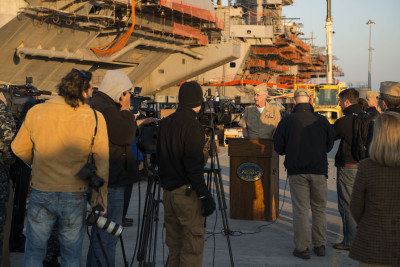
Looming budget restrictions means the U.S. Navy will reduce the American presence in U.S. Central Command from two aircraft carriers to one for the immediate future, a defense official told USNI News on Wednesday.
A deployment of the USS Harry S. Truman (CVN-75), planned for later in February, has been delayed to preserve operating a carrier in the Middle East well into 2014, the official said.
The move would save “hundreds of millions,” in fuel and maintenance reaquired to operate the Truman and the accompanying guided-missile cruiser that was part of the planned deployment, the official said.
Instead, the Truman will be kept in a ready status near its homeport in Norfolk, Virginia, in case the ship, its crew and carrier air wing would need to surge in support of forces abroad.
Currently, the John C. Stennis (CVN-74) is alone in the region and will be relieved by the Eisenhower (CVN-69), which returned from Central Command in December for maintenance.
The change from the Pentagon comes after the Navy released its plan for dealing with the looming cuts from sequestration, the ongoing budget shortfalls with the stymied Fiscal Year 2013 budget, and the ongoing continuing resolution. Combined they could force the service to quickly reduce its budget by $9 billion primarily from the service’s operations and maintenance accounts. Those cuts could reduce flying hours from deployed carrier air wings by 55 percent, cancel naval operations focused on drug- and human-traffic interdiction in South America and reduce training overall.
“Facing budget uncertainty—including a Continuing Resolution and the looming potential for across-the-board sequestration cuts—the U.S. Navy made this request to the Secretary and he approved, Pentagon spokesman George Little said. “This prudent decision enables the U.S. Navy to maintain these ships to deploy on short notice in the event they are needed to respond to national security contingencies.”
Responding to requests from Central Command combatant commanders, the Navy has had two carriers in the region for the past two years. The arrangement resulted in nine months of a dual carrier presence in the Middle East, until today’s announcement. In the past, U.S. carriers have been responsible for up to a third of the air strikes in Afghanistan since the start of Operation Enduring Freedom.





